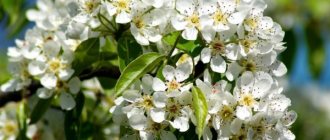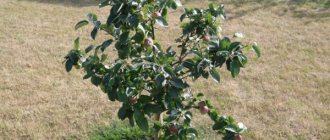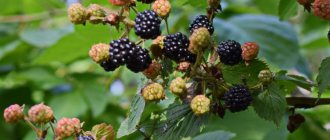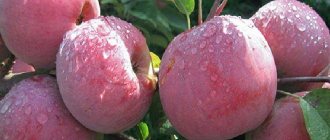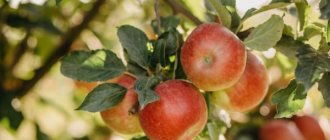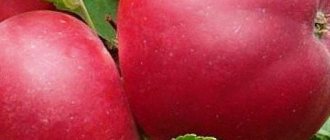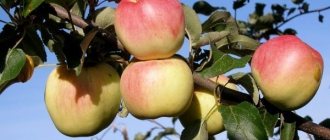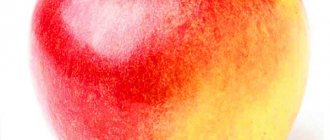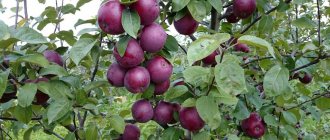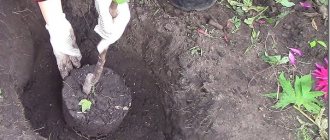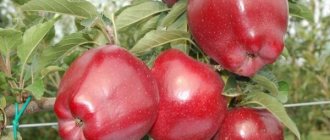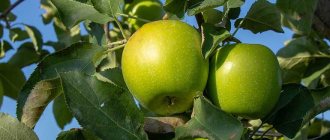Planting dwarf apple trees
Propagation of a dwarf apple tree by root cuttings differs from the propagation of ordinary apple trees. It is difficult to vaccinate yourself to obtain a dwarf apple tree; it is easier to purchase a ready-made seedling from a special nursery. When purchasing seedlings on the market, you can easily make a mistake. When purchasing, you need to make sure that there is a clear knee-shaped protrusion between the seedling trunk and the root collar. This is the vaccination site. A two-year-old grafted seedling has at least 4 branches with large buds. The wild one will have many branches without buds.
A dwarf apple tree has a root system with small roots, while a wild seedling will have a taproot. After purchase, the seedling is wrapped in a damp cloth and covered with polyethylene on top. Before planting, you should shorten the branches. When are dwarf apple trees planted? Dwarf apple trees are planted in autumn or early spring.
Planting a dwarf apple tree in autumn
Autumn planting of an apple tree on a dwarf rootstock in the fall occurs during the period when the plant goes into a dormant state (September-October). Apple trees of this species love places protected from the wind, semi-shaded or sunny. The soil should be fertile, moist, loose. It is better to choose loam or light soil.
A planting hole with a diameter of 59 cm and a depth of 70 cm is being prepared. When digging a hole, you need to discard the top layer separately, mix part of this soil with peat or humus, add wood ash and superphosphate. Drive a stake into the center of the hole, pour a nutritious soil mixture around it, and top with a layer of regular soil. Place the seedling, straightening the roots, fill the hole with the remaining soil without fertilizer.
It is necessary to ensure that the grafting site is 3 centimeters above the surface. The roots of the seedling should not come into contact with fertilized soil, otherwise fertilizers may cause burns to the roots. When planting several trees at once, you need to place them at a distance from each other. The soil around the seedling is trampled down, retreating half a meter from the trunk, and an embankment about 15 cm high is made. About 30 liters of water are poured onto the circle around the trunk. The tree trunk circle, after water has been absorbed by the soil, is mulched with a layer of peat. You can use humus. The seedling is tied to a support. A layer of mulch is placed slightly away from the trunk of the apple tree. The planting diagram of dwarf apple trees in relation to buildings, fences and other crops is shown in the figure.
You may be interested in: Planting apple trees with high groundwater levels
Planting a dwarf apple tree in spring
Planting apple trees on a dwarf rootstock in the spring is carried out only when the snow has melted, the soil is no longer frozen, soft, but the buds have not yet opened. It is better to prepare holes for planting in the fall, immediately fill them with soil mixture, and leave them until spring. Over the winter, the soil in the hole will become compacted, settle, and the fertilizer will dissolve.
In the spring, a stake is driven into the hole, a layer of good soil is poured around it without fertilizing, and a seedling is installed. Further, all manipulations repeat the process of autumn planting.
Winter
Winter varieties can be harvested in late autumn
These semi-dwarf varieties are suitable for the Moscow region; they ripen in late autumn and have a long shelf life.
Grushovka
One of the oldest varieties with high immunity from diseases and parasites. The tree enters the fruiting phase in the 5th or 6th year after planting. Despite low yields, it bears fruit every year.
The apples are small - they weigh about 100 g. They taste sweet, with a slight sourness. The aroma is pronounced.
Bogatyr
The first fruits on the tree appear 5-6 years after the seedling is planted. It is characterized by intensive growth, so it needs pruning annually. Proper cutting of shoots increases the amount of harvest - young growth is trimmed annually by 1/3 of the length.
Low-growing apple trees are highly frost-resistant, they are also resistant to diseases and are practically not affected by pests.
The fruits are small - their weight is up to 80 g, round in shape, slightly compressed in the area of the stalk. Color: yellowish-red. The variety is valued for its long shelf life - about 9 months.
Moscow necklace
The tree is short - 2.5-3 m, does not have strong growth, so pruning is not necessary. The first harvest is given in the third year of life. The variety is resistant to scab and successfully withstands severe winters.
The fruits are harvested in mid or late October. The average fruit weight is 150 g. The skin is burgundy-colored, the flesh is pink, sweet, juicy. The shelf life is long - up to six months.
Arbat
A dwarf columnar variety with high yields - up to 30 kg of apples can be harvested from one mature tree.
The fruits are small in size, weigh 100-120 g. The shape is round, slightly flattened. The skin is scarlet with yellow elements. The pulp is creamy, juicy and very sweet.
Bolero
Fruits can be stored fresh for up to six months
The low-growing hybrid bears large green fruits, their weight is about 200 g. The harvest is very tasty, juicy and sweet, harvested in the last ten days of September or early October.
Valued for its excellent presentation and good shelf life - up to 6 months.
Apple trees are self-fertile, so they do not need nearby pollinating varieties.
How to care for dwarf apple trees
Caring for dwarf apple trees in spring
Dwarf apple trees are easier to plant and care for, but you need to know some features. In early spring, the branches of young seedlings need to be shortened. In mature plants, sanitary and formative pruning should be carried out. Before sap flow begins, it is necessary to carry out preventive treatment against pests and diseases. To protect against harmful insects, trapping belts are installed and secured to the trunks.
The root system of a semi-dwarf is superficial, so you need to ensure that the soil in the tree trunk does not dry out. After watering, loosen the soil to a depth of 5-7 cm. Mulching will help the moisture not evaporate. In April, it is necessary to whitewash the bases of skeletal branches and trunks with lime. Low-growing trees need spring fertilizing with complex or nitrogen fertilizers.
Caring for dwarf apple trees in summer
In summer, it is necessary to monitor the soil moisture around the trees. It is very important to pay attention to the fight against harmful insects. You can use special chemicals or folk remedies.
In summer, fertilizing is carried out using a foliar method; microelements are added to the fertilizer solution, for example, iron, which apple trees often lack. After the apples begin to ripen, you need to think about supports for the branches.
Caring for dwarf apple trees in autumn
Most varieties of semi-dwarf apple trees ripen in the fall. The main task at this time is to harvest. Tree trunk areas must be kept clean, and carrion must be removed in a timely manner. After harvesting, apple trees are fed with mineral fertilizers and sanitary pruning is carried out.
In tree trunk circles, the soil is cleared of cuttings of branches and fallen leaves, and then loosened. This will disrupt the thermal insulation and prevent pests from remaining in the soil for the winter. By mid-autumn, it is necessary to carry out preventive treatment of the dwarf apple tree against pests and diseases. Trees begin to prepare for wintering in late autumn.
You may be interested in: Processing apple trees in spring
Winter varieties
Late ripening fruits do not immediately reveal their taste qualities. To achieve full ripeness, they need to rest for 1-2 months.
They are stored almost until the new harvest, subject to the temperature schedule and optimal humidity indicators.
Grushovka
The variety has been tested by time, has its long-time fans, is distinguished by high productivity, excellent characteristics in transportation and storage.
Fruiting begins in the 5th year, the apples are small, oval, and green at technical ripeness. In the process, they acquire a yellowish tint and a pronounced fruity aroma.
Moscow necklace
The tree grows up to 2.3 m, the crown is compact and does not require additional pruning. The branches are formed horizontally, which is very convenient when harvesting.
It bears fruit annually at the end of October. The fruits are small, spectacular burgundy in color with a slight waxy coating. The skin is dense, the flesh is juicy. The harvest can be stored for 5-6 months.
The apple tree withstands long-term frosts and temperature changes, and forms an abundant ovary.
Bogatyr
Despite the name, the fruits are small. Bogatyrsky can be called the health of a tree, its resistance to adverse weather conditions, diseases and pests. A very valuable quality is the ability of apples for long-term storage and long-distance transportation, up to 9 months.
The tree requires constant formative pruning. To avoid thickening of the crown, it will have to be shortened annually by a third of the length of the branches.
Variety Bogatyr must be pruned regularly
Benefits include:
- high productivity;
- resistance to typical diseases, including scab;
- quick adaptation when landing;
- winter hardiness.
Apple trees are often used as a pollinator for other varieties. Popular winter varieties also include Bolero and Arbat.
Processing dwarf apple trees
Before the buds swell in the spring, dwarf apple trees must be sprayed with Bordeaux mixture (1%) or Nitrafen. These products will destroy pests that have successfully overwintered in the soil and in the bark of trees. Trees can be treated with urea solution (7%). This will provide both nitrogen fertilization and protection from insects and pests.
Treatment is carried out before the buds open, otherwise the plant will get burned. After leaf fall, autumn preventive treatment of apple trees is carried out with a solution of Nitrafen or Bordeaux mixture (1%).
Rating of varieties
According to tasting assessment of fruits
According to their taste, apples of the Confectionery and Melba varieties are the sweetest , and Melba fruits also have a caramel flavor.
And reviews of the fruits of the Bogatyr variety say that they are the most sour.
Resistance to diseases and pests
Among the varieties grown in the Moscow region, the most resistant to diseases and insect pests are considered (you could see their photos and descriptions above):
- Zhigulevskoe;
- Bogatyr;
- Grushovka Moskovskaya.
According to winter hardiness
The most winter-hardy varieties of dwarf apple trees for the Moscow region are the dwarf apple tree Bogatyr.
By fruit size
This is the Autumn Striped variety .
Watering dwarf apple trees
Apple trees that have not yet bear fruit are watered three times a year (5 buckets of water per tree). The last watering is carried out at the beginning of August. Apple trees that bear fruit need to be watered more often. They are watered up to five times a year.
Each tree growing on sandy loam soil needs four buckets of water, and on loamy soil - six buckets. In dry summers and autumns without rain, winter watering of dwarf apple trees is necessary. The moisture should wet the soil to the depth of the roots. Per square meter of garden you will need 10 liters of water. Pre-winter irrigation is not carried out if the groundwater level in the areas is already high.
Summer
This group includes early-ripening hybrid forms, harvested at the end of summer. After reading their description, you can choose a variety for your area.
Melba
In the third year of cultivation, the trees begin to bear the first apples. Fruit picking takes place at the end of July. The plant is prolific - at maturity it produces about 40 kg of fruit.
The apples are spherical, slightly elongated, weighing 0.2 kg. The skin is lime-colored and contains light yellow longitudinal stripes. At the end of ripening, a reddish blush appears on the fruits. The pulp is very sweet, aromatic, white with a caramel flavor.
The shelf life of the crop in a cool, well-ventilated area is 3-4 months.
The best pollinating varieties are Suislepskoe and Borovinka.
Candy
Gives tasty, small apples - their weight is 120-130 g.
The fruits are traditionally round in shape, with a glossy light green skin. The inside is dense, juicy with a pronounced apple aroma. The harvest begins in early August.
The president
The variety will delight you with its productivity
A dwarf apple tree, its maximum height is 2-2.5 m, its circumference is 2 m. Winter hardiness is high - it can withstand temperatures down to -30°.
Large-fruited variety (weight 150-250 g). The apples are round, yellow in color with a blush on the side and a sweet-sour taste.
From a young plant you can harvest 5-7 kg of fruit, mature trees yield up to 20 kg.
Disadvantage - the fruits cannot be stored for a long time; they quickly deteriorate (1.5 months after picking).
Feeding dwarf apple trees
The root system of the dwarf apple tree is small with high fruiting. It is necessary to fertilize with fertilizers regularly - once every 14 days. Apple trees in the second and third years of life are fertilized with complex fertilizer at the rate of 30-40 g per bucket. Twice a season, the dwarf apple tree is fertilized with a solution of chicken or cow droppings.
In summer, apple trees need foliar feeding with complex mineral fertilizers. The leaves are sprayed on both sides. This is done in dry weather without wind. Foliar feeding of apple trees with urea is effective. But you need to remember that the solution must be weak so as not to burn the plant. It takes place no later than September.
Nitrogen is not included in the autumn fertilizing, otherwise it will delay the preparation of trees for winter. Apple trees need phosphorus and potassium in the fall. You can use double superphosphate; you will need two tablespoons of it per ten-liter bucket of water.
Autumn
This group consists of varieties of dwarf apple trees for the Moscow region, the ripening period of which varies from the beginning of September to the end of October.
Dwarf hybrid form - in adulthood reaches 2 m in height.
The apples are bright fiery in color, average weight is 0.2 kg. The harvest takes place in September.
The first fruits appear two years after planting. Every year the tree increases the amount of harvest. Up to 15 kg can be removed from a five-year-old tree.
Zhigulevskoe
The tree forms the first fruit ovaries in the 3-4th year of cultivation. The harvest takes place in the last ten days of September.
The variety is large-fruited (weight 300 to 350 g). The apples are bright red, very juicy, sweet with a slight sourness.
This is one of the most disease- and parasite-resistant autumn ripening varieties.
The disadvantage is poor frost resistance, so trees need good shelter for the winter.
Streifling
The variety Streifling (or Autumn Striped) bears small fruits (their weight is 150-200 g). The apples are round or oval, green with vertical light yellow stripes. They taste sweet, with a slight sourness.
The tree has a superficial root system, so its resistance to winter cold is very weak. To avoid freezing of the roots, the trunk area is mulched with a thick layer of horse or cow manure, and the trunk is covered with roofing material or spunbond.
The harvest takes place in September.
Glory to the Winners
This variety of apple trees, growing in the Moscow region, ripens in early September.
The apples are small - weigh 120-180 g. Light green or yellow, with a reddish blush. They taste sweet.
Related article: Bacopa ampelous: growing from seeds, photos, planting and care at home and in the garden
Pruning dwarf apple trees
In order for dwarf apple trees to enjoy a high yield, you need to form a crown. It needs to be formed in March-April. At the same time, anti-aging and sanitary pruning is carried out. Sanitary pruning of trees is carried out in the fall, when the harvest has already been harvested.
There are several types of dwarf tree crowns: flat spindle, dwarf pyramid, slender spindle, free palmette. The most popular type of crown is “dwarf pyramid”. With this pruning, the result is a low tree, the average length of whose branches is about a meter.
